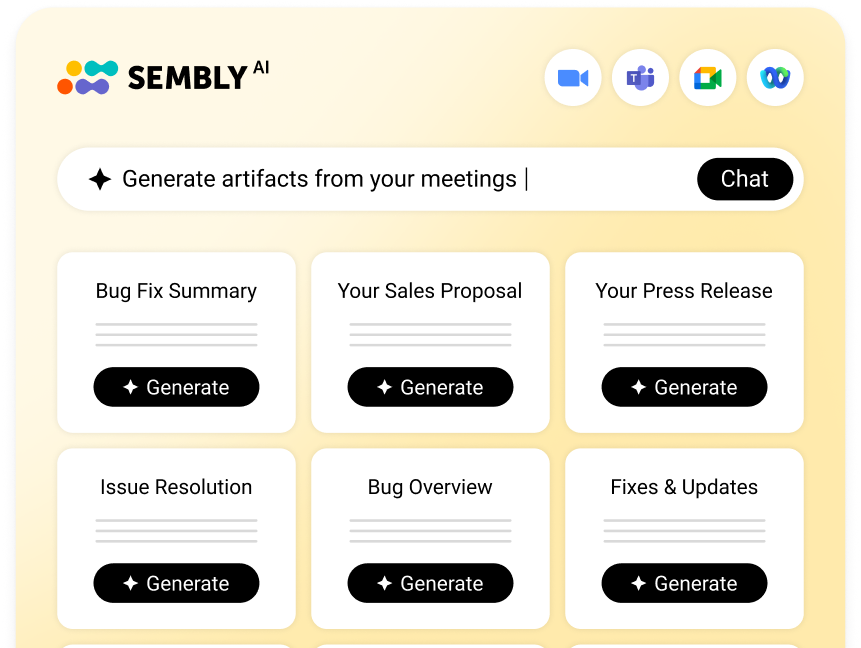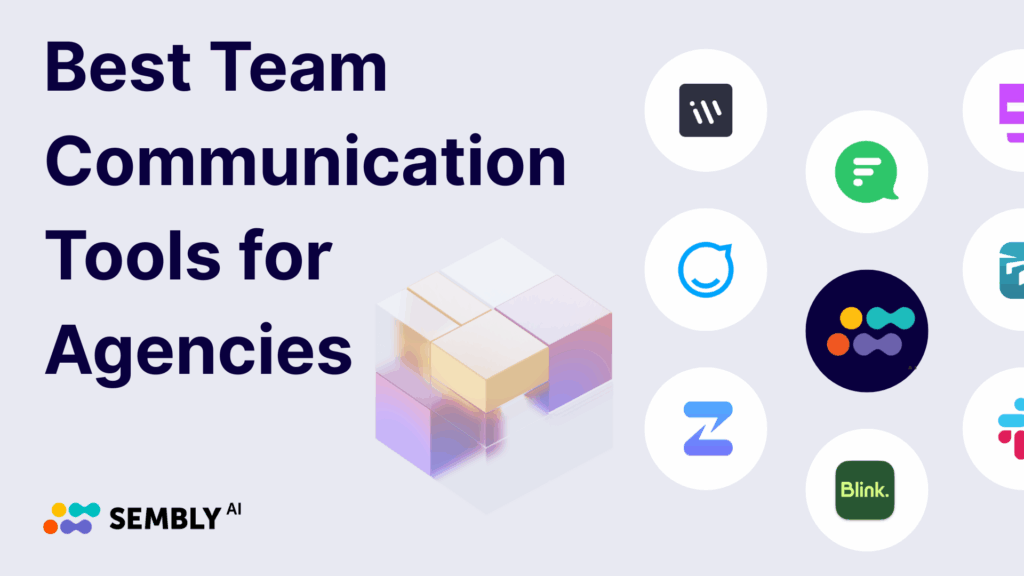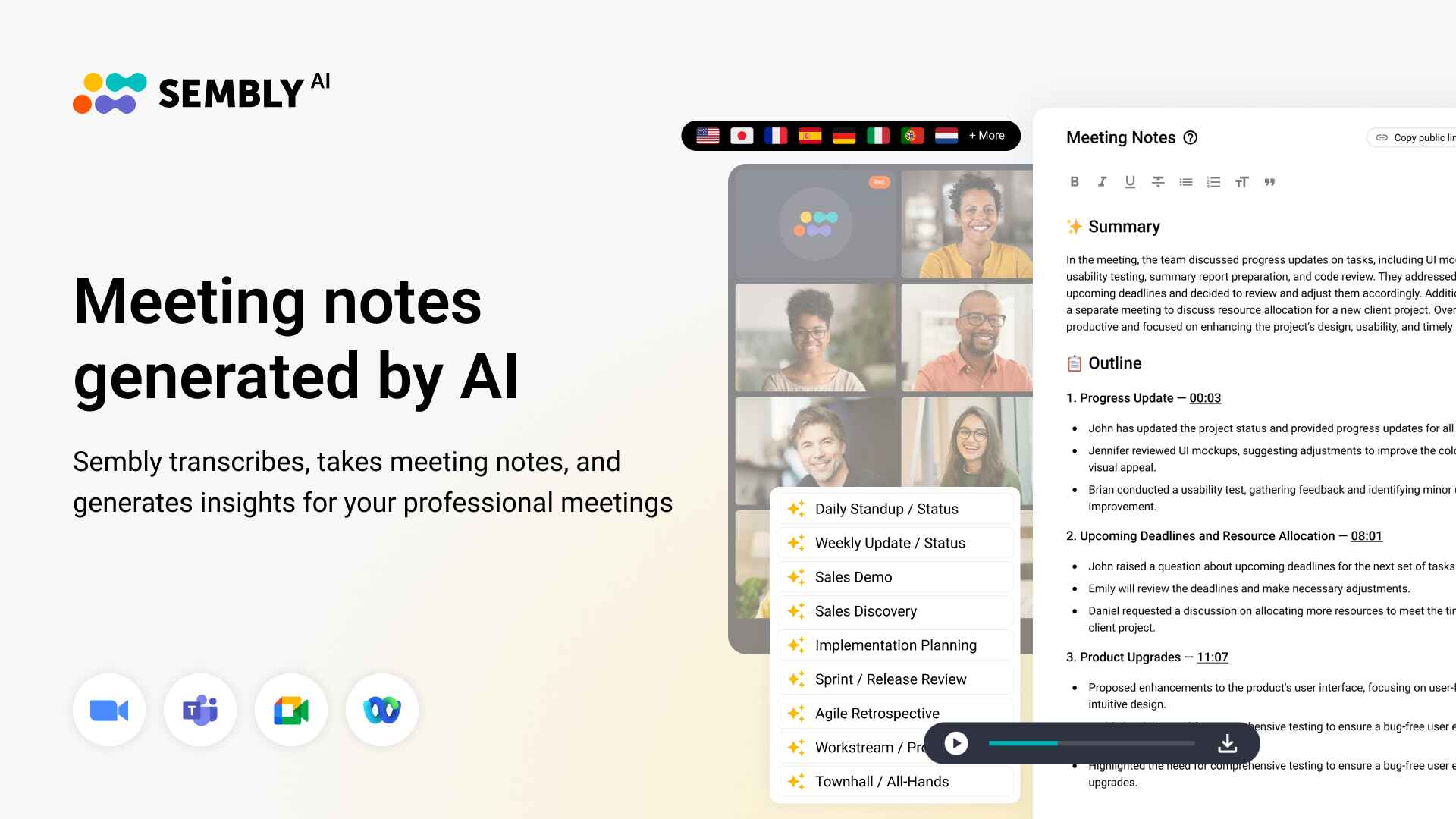Table of Contents
Toggle3 in 4 business leaders agree that their teams struggle to maintain effective internal communication (Grammarly). However, you do not need reports to know there is a problem. When your creative lead messages you on Slack, the account manager replies via email, and the designer leaves a comment in a Trello card, chaos begins.
In agency environments, where professionals manage multiple projects and clients simultaneously, this kind of communication is critical. It often leads to missed deadlines, poor customer experience, and employee burnout. Surely, it does not have to end this way. With team communication software, agency professionals can collaborate effectively and focus on what’s truly important: clients.
In this article, we will discuss the best apps that cover different aspects of communication and help you choose the best solutions for your business. Shall we get started?
Why Communication Tools Matter for Agencies
Miscommunication is always a risk that can impact timelines, stall revenue, and negatively influence trust. The primary issue lies in unstructured messaging across numerous platforms, with no central source of truth.
Since it is a complex topic, I suggest that we break it down into key points and discuss some of them in detail:
- Inconsistent communication: When teams rely on different communication channels, it often leads to conflicting versions of instructions or repeated questions.
- Context switching: Switching between email, chat, voice notes, and task boards reduces employee productivity, which negatively impacts ongoing projects.
- Delayed decision-making: Disconnected employee communication tools also delay feedback and lengthen approval cycles.
- Low accountability: There is no way to track deliverables or check responsibilities & employee progress when important details are scattered across tools.
- Poor remote collaboration: Without effective asynchronous communication tools, work-from-home employees struggle to connect. As a result, professionals end up isolated and unproductive.
The idea is simple: strong business communication is the backbone of every successful agency. It aligns teams around the same goals and prevents misunderstandings from becoming costly mistakes.
What to Look For in a Team Communication Tool
What sets effective apps for employee communication apart from the generic ones? The short answer is their features and potential. The best solutions fit the way teams collaborate, scale with your projects, and protect your time and internal data.
Let’s take a look at 5 key features to look for:
- Multi-layered communication: Prioritize platforms that support chat, video, voice, async notes, and screen sharing to ensure each employee has access to a convenient communication method.
- Integration options: Look for team communication apps that integrate with project and task management, creative, CRM, and documentation tools.
- Role-based access & collaboration: Ensure the platform lets you invite clients as guests, restrict channel access, and maintain full visibility.
- Searchable message history: What are great internal communication apps without a search feature? Ensure your options support search across chats, files, and channels.
- AI & automation: Search features such as automated meeting transcriptions & notes, smart suggestions, or AI chats that help find information across all channels.
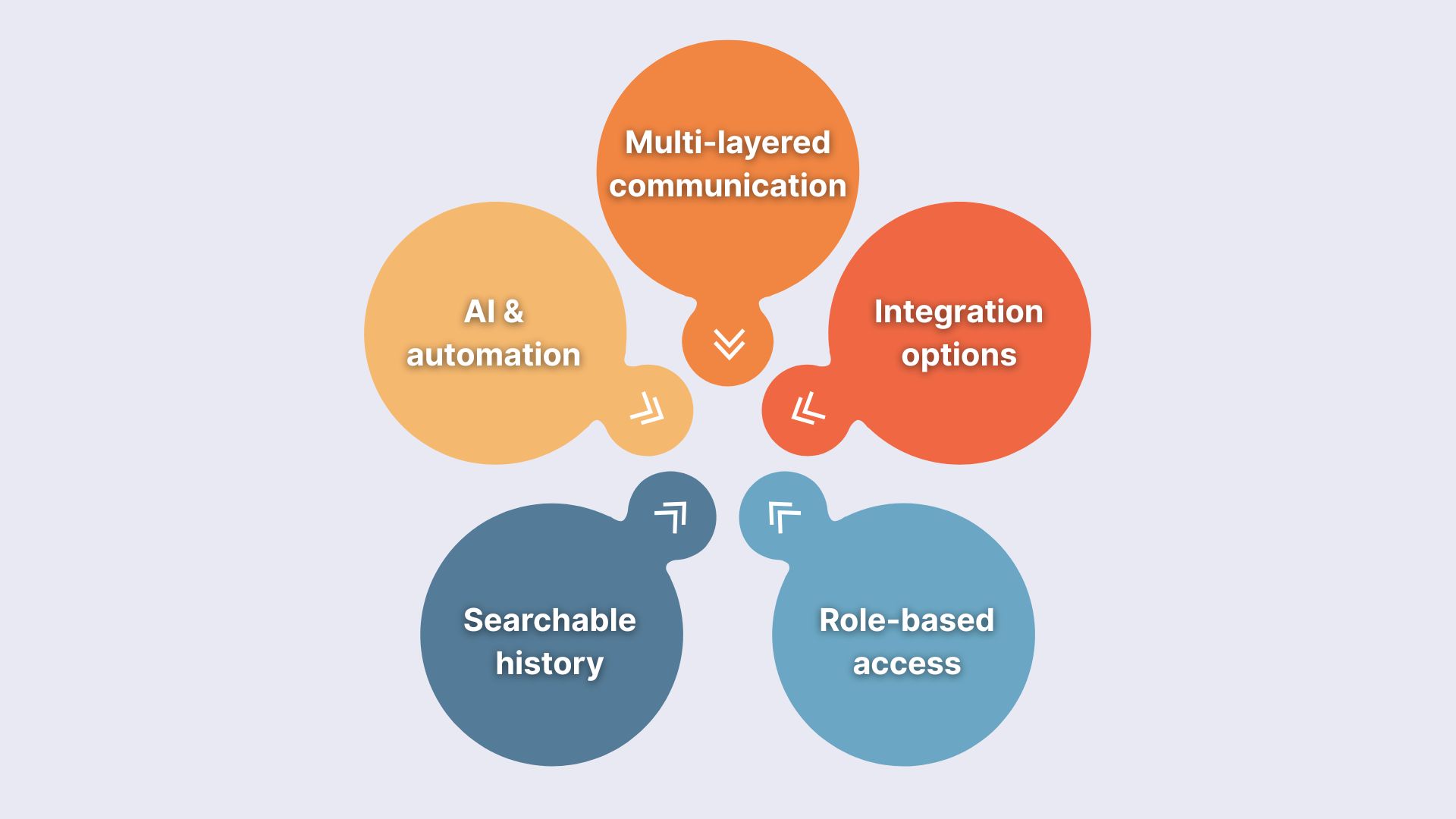
With these core features in mind, I suggest that we move to the next section and discuss the team communication tools that agencies can trust.
Top 11 Team Communication Tools for Agencies
So, what are the best team communication tools that have proven their effectiveness and earned trust? I have prepared a list of platforms that help agencies structure conversations, improve team collaboration, and keep every employee aligned.
1. Sembly AI
Have you ever had a brilliant insight during a call and then struggled to communicate it to your team? Or worse, repeated the same project update in multiple threads? Sembly AI is designed to eliminate these problems. It captures the full conversation in over 45 languages, extracts action items, and turns them into shareable insights. Furthermore, Sembly can generate comprehensive documentation, such as status plans, project or retrospective reports, based on the meeting content.
Let’s say you just finished a strategy call with a customer. Instead of going through the recording or manually creating notes, you share an AI meeting summary with your colleagues. As a result, everyone’s aligned, without ever joining the conversation.
Key Features
- Records, transcribes, and summarizes meetings automatically
- Extracts tasks and key items (risks, events, issues, or notable events)
- Generates AI insights with a description, next steps, and suggested deliverables
- Automatically post-meeting notes to channels on Slack and MS Teams
- Answers any meeting-related questions in the AI Chat
- Automates meeting documentation: project plans, feature overviews, status plans, or customer feedback reports
Best for
- Agencies that manage multiple clients
- Distributed or remote teams working asynchronously
- Teams that rely on accurate meeting documentation
- Sales, marketing, or product leads who need searchable records
2. Microsoft Teams
Microsoft Teams is the second pick for agencies that actively use the Microsoft 365 package and need a tool that seamlessly integrates into existing workflows. Teams is a collaboration workspace built for professionals using the Microsoft 365 ecosystem. The app combines messaging, video calls, file sharing, and workflow tools into one centralized hub. Professionals can easily co-edit documents live, host brainstorming sessions with Microsoft Whiteboard, and even generate AI meeting summaries. The idea is to reduce switching between the tools and provide the core communication functionality in one solution.
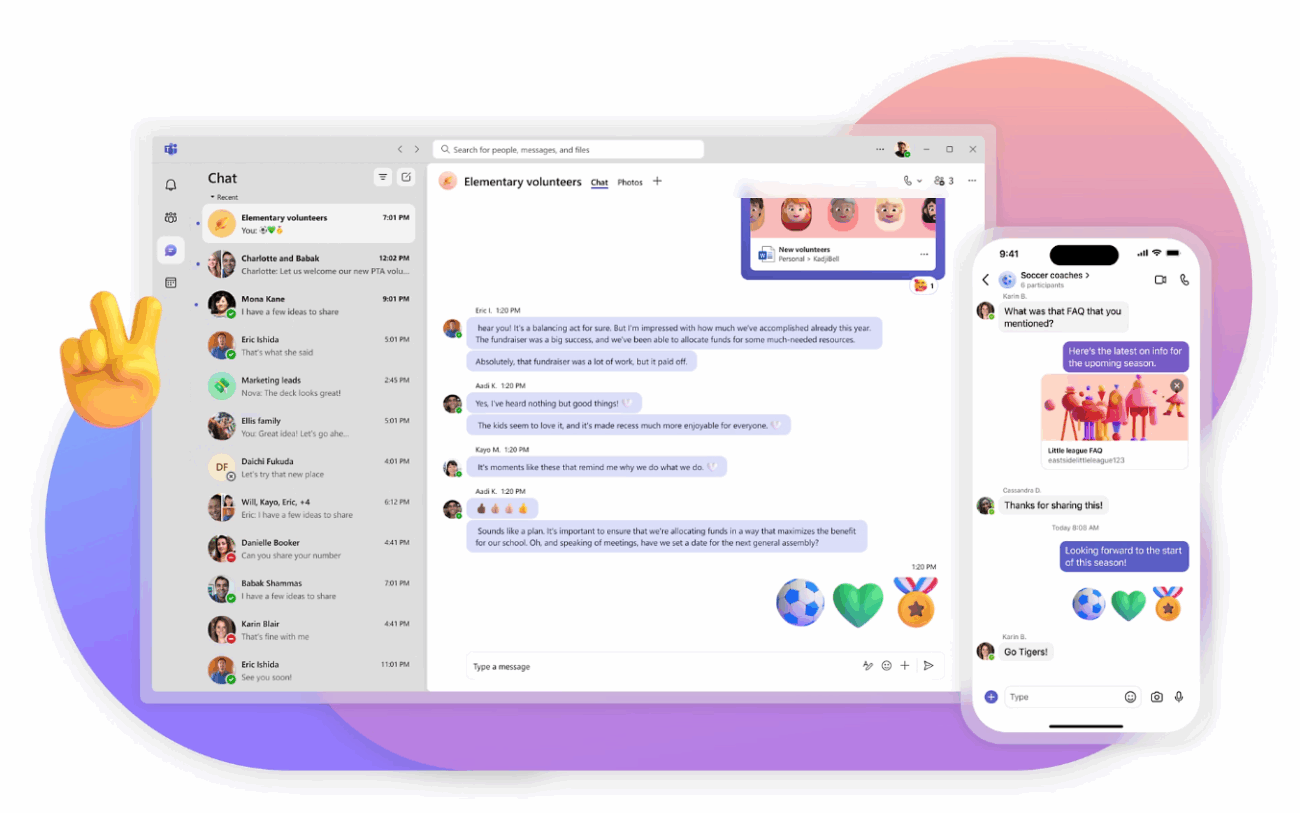
Key Features
- Persistent channels & threaded conversations for topic-based discussion
- Video conferencing with PowerPoint Live, Whiteboard, and breakout rooms
- Calling features: group calls, voicemail, call transfers
- A large list of built‑in apps: Planner, Tasks, Approvals, and Lists for lightweight task & workflow management
- AI features for meeting summaries, automated notes, and context-aware prompts
Best for
- Agencies that use Microsoft 365 and want deep integration across Office tools
- Teams that run hybrid operations and need a single hub for chat, meetings, and files
- Cross‑functional agency teams that benefit from shared context
- Agencies that target enterprise clients where compliance, governance, and security matters
3. Workvivo
Would you like to replace chaotic messages with a centralized feed for updates and employee engagement? Then, consider Workvivo. It is an employee experience and communication platform that is designed to keep distributed teams connected. With native chat, video calls, polls, and automatic translations, it’s a great solution for agency professionals across time zones, roles, and departments.
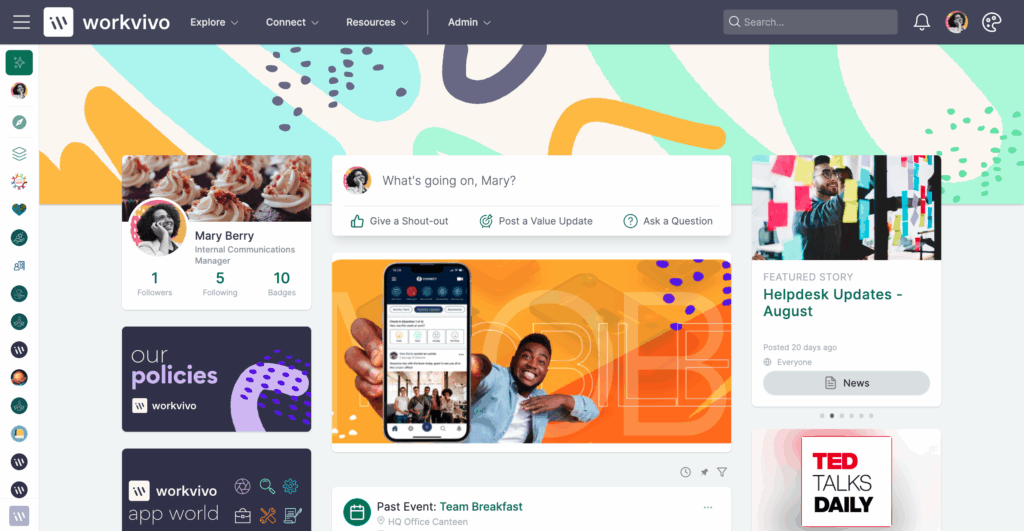
Key Features
- Surveys & polls, community spaces, events
- Smart feed, posts, podcast, live-streaming, comments
- Native chat, voice & video
- Employee engagement, content, competition, and governance analytics
- AI content creation, surveys, and AI chat that answers questions
Best for
- Enterprises that need to unify internal communications across dispersed teams
- Hybrid employees who need mobile-first team communication tools for active engagement and updates
- HR professionals who need to boost team culture, recognition, and alignment
4. Flock
Are you looking for real-time communication apps for business? Flock can be a good fit. It combines channels, tasks, notes, and automation in a single platform, allowing agency employees to chat, join video calls, share files, and assign action items. The app also includes productivity features such as shared to-do lists, polls, reminders, as well as an integrated file search.
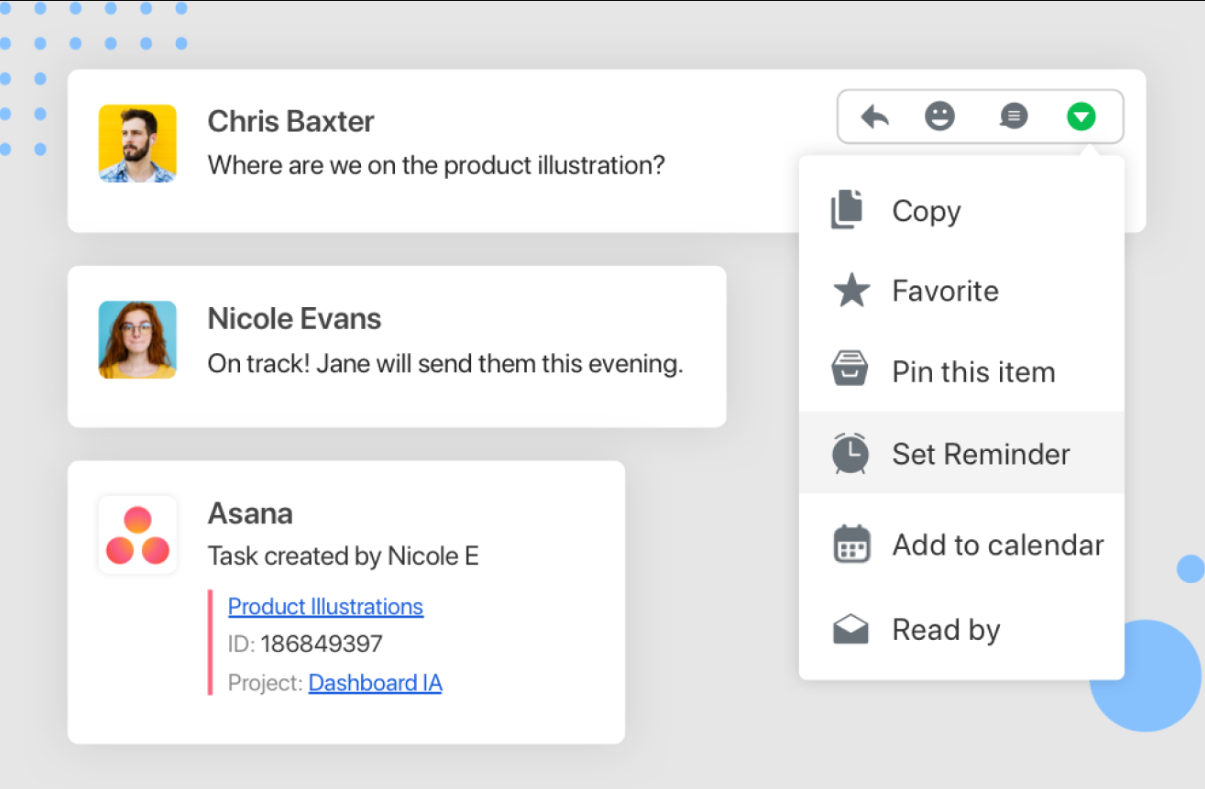
Key Features
- Real-time messaging, group chats, and channels
- Video conferencing, voice notes, channel messaging
- To-dos, shared notes, polls, reminders
- Admin controls, data retention, and user permissions
- Integrations with over 60 apps listed on the Flock Appstore
Best for
- Small to mid-sized teams that need real-time messaging & productivity features
- Agencies that look for all-in-one team communication apps for chat, tasks, video calls, and notes
- Teams that manage campaigns, daily workflows, or creative projects in shared spaces
5. Spike
Spike is a good choice for teams that want to combine messaging, shared inboxes, notes, tasks, and video calls into one workspace. The app enables professionals to invite non-Spike users via email, improving internal and external communication. It also supports collaboration on files, voice messages, AI writing & summarization, and search across all content.
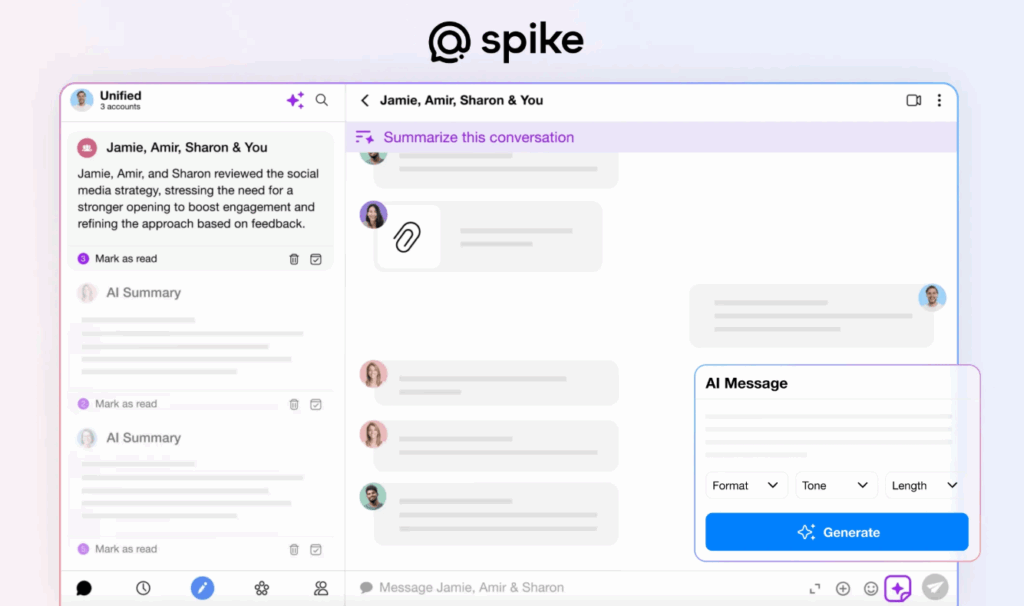
Key Features
- Conversational email: chat-style view of emails grouped by person
- Shared inbox & teams, groups for collaboration
- Collaborative documents, tasks & notes
- Video and voice calling system, screen sharing
- Priority & unified inbox, Super Search, file & attachment management
Best for
- Agency teams that need to combine email, chat, and collaboration into one workspace
- Agencies that handle client communications and internal work in the same app
- Remote or distributed teams that need company communication apps for sharing context and documents
6. Staffbase
Staffbase is an employee communication and intranet platform built to help large organizations ensure consistent messaging across all workspaces. It connects managers and employees through feeds, branded mobile apps, and multi-step sequences.
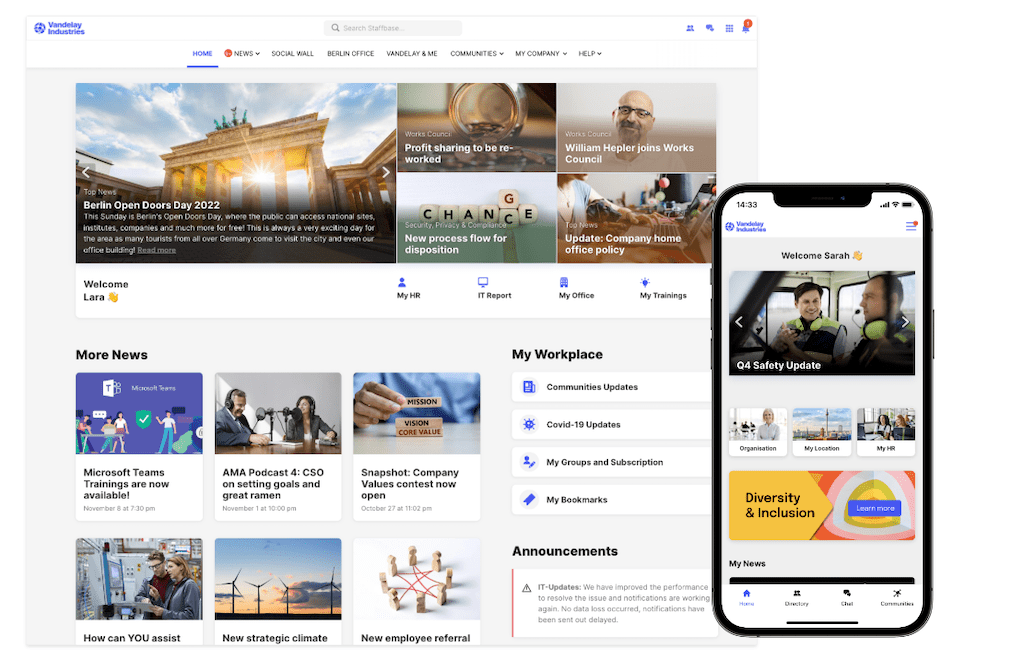
Key Features
- Centralized employee communication and branded intranet
- Personalized content targeting by role, department, or location
- Branded mobile apps with push notifications and engagement analytics
- Built-in internal email, newsletter, and campaign creation tools
Best for
- Enterprises and agencies that manage large teams across time zones want them to have effective team communication apps
- Internal communications and HR departments focused on company culture
- Organizations that need to unify digital tools and improve internal messaging
7. Blink
Is your agency looking for mobile-first employee experience and team communication tools? Blink can be a good candidate. It is designed to connect async teams through one unified platform. Blink offers newsfeeds, secure chat, content hub, forms, surveys, and voice & video calling. Overall, it is a good option if you need to replace disconnected intranets.
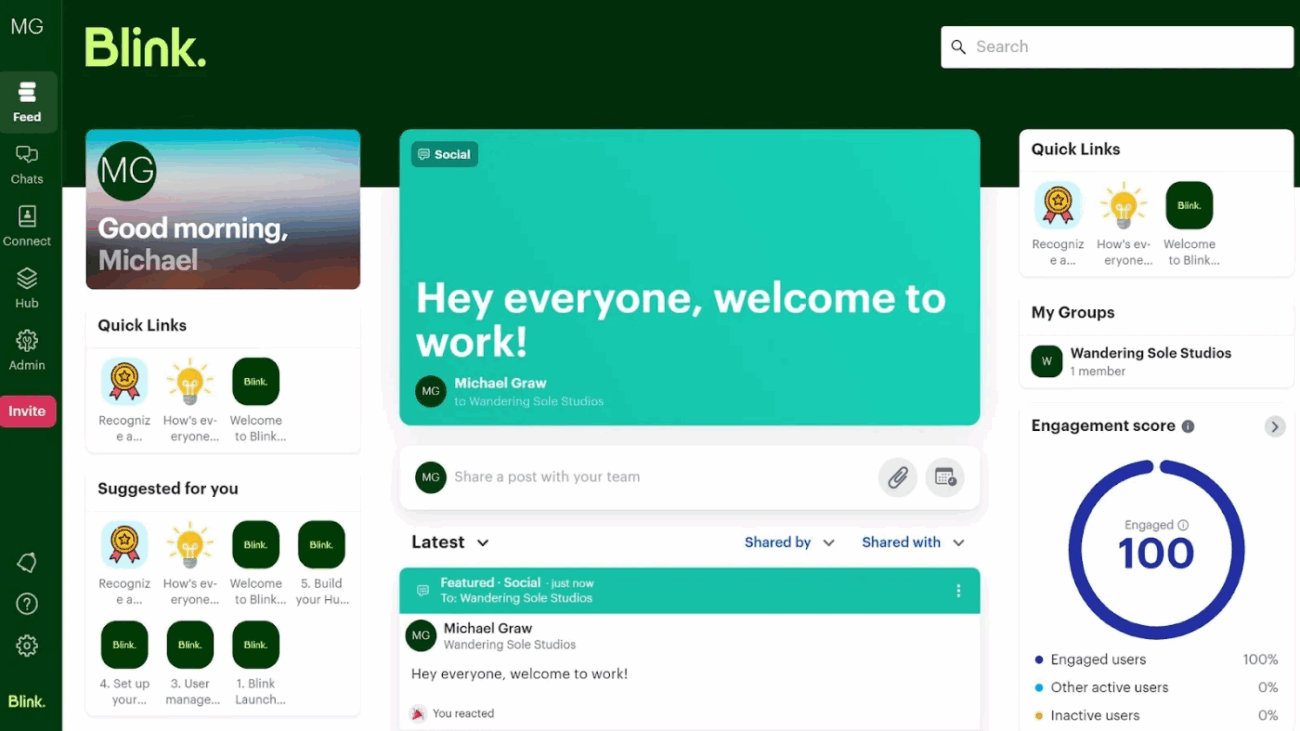
Key Features
- News feed, stories, and social-style internal communication
- Secure one-on-one and group chats, built-in voice and video calls
- Content hub for policies, guides, resources
- Digital forms & surveys for feedback loops
- Analytics & insights on engagement and reach
Best for
- Agencies that prioritize hybrid or remote work and need a mobile-first communication hub
- HR teams that want to centralize announcements, forms, and content
- Agencies that need to reduce email & intranet noise
8. Axero
What if the agency needs team communication apps that combine communication, knowledge sharing, and task management? In this case, consider Axero. It is a unified intranet, social collaboration, and employee portal platform. The app supports news & announcements, real-time chat, activity streams, content hubs, and workflow tools.
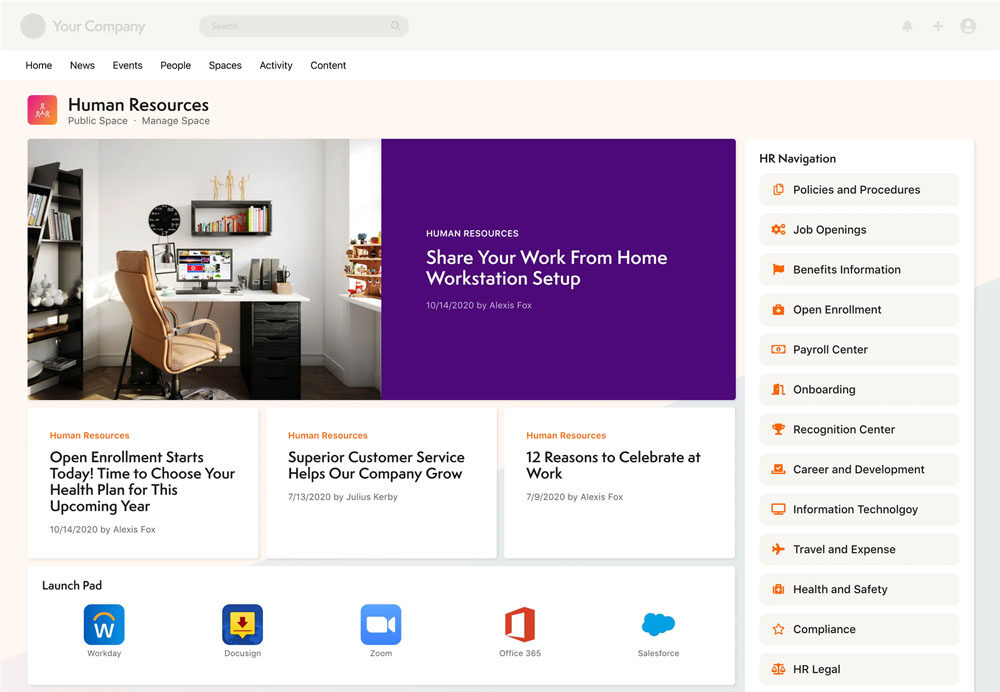
Key Features
- News, announcements, activity streams, chat & messaging, forums
- Task management with priorities, categorization, and a drag-and-drop interface
- Granular permissioning, private and public spaces & role-based visibility
- Content publishing, templates, file attachments, and version control
Best for
- Agencies that need a central intranet and portal for internal communications
- Teams that need to combine announcements, collaborative content, and task tracking
- Agencies or enterprises that prefer structured content hubs and internal social features
9. Zulip
Zulip is a good choice for teams that need topic-based threads to support both real-time and asynchronous collaboration. The app helps to keep conversations organized by splitting them into streams and topics. As a result, conversations remain focused and revolve around the key topic. Zulip can also be self-hosted or cloud-based and is used by both technical and non-technical agency specialists.
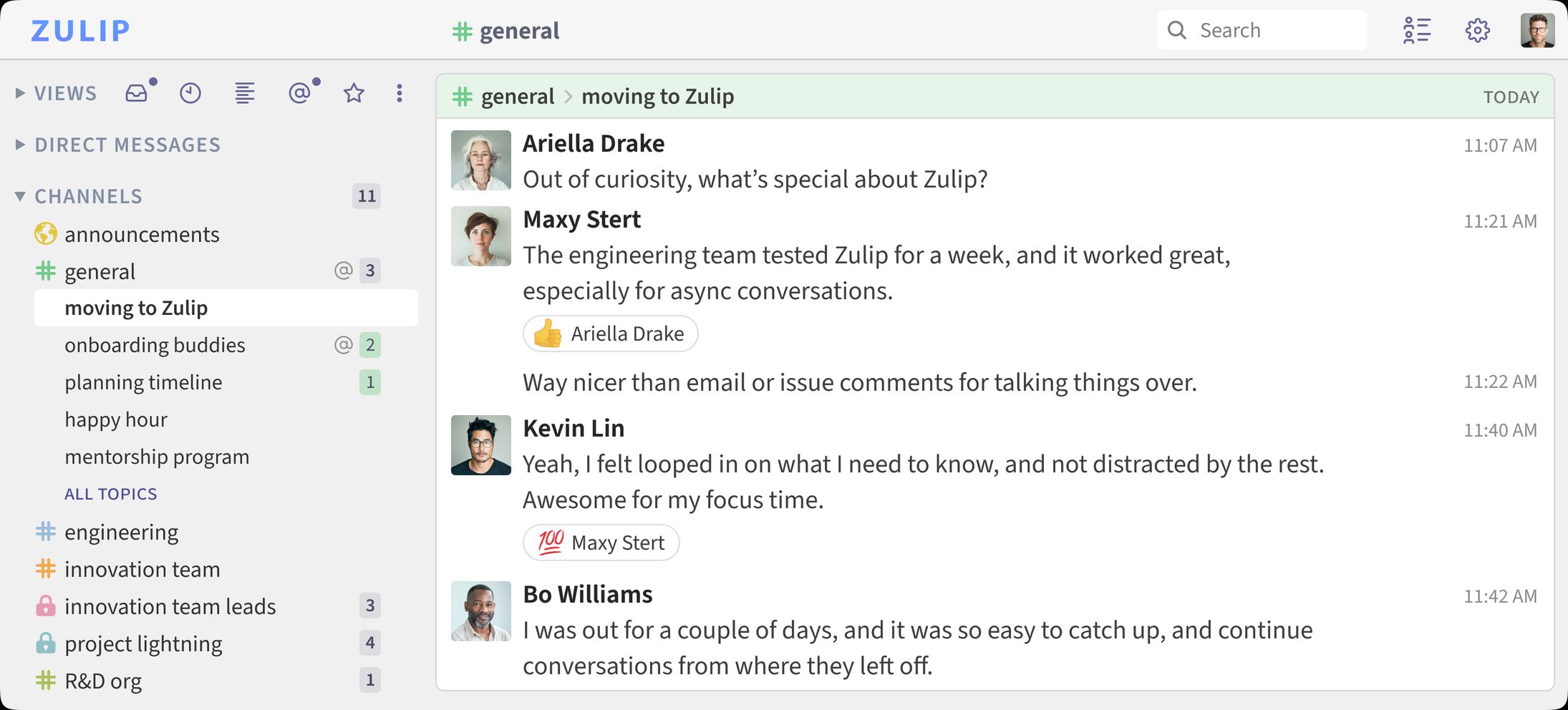
Key Features
- Topic-based threading, channels, voice, and video calls
- Message history search
- File sharing and storage
- Open source & self-hosting deployment option or cloud version
- 130+ native integrations, localization in 20+ languages
Best for
- Agency teams that need both real-time and asynchronous team communication apps
- Organizations that need the flexibility of open source or private hosting
- Professionals who manage multiple conversation threads where context matters
10. Connecteam
Is your agency team looking for workforce management & team communication tools? In this case, consider Connecteam. This platform focuses particularly on remote and asynchronous teams, centralizing communication, scheduling, tasks, and time tracking. Professionals can send messages, assign tasks, share files, and maintain checklists using both personal computers and mobile devices
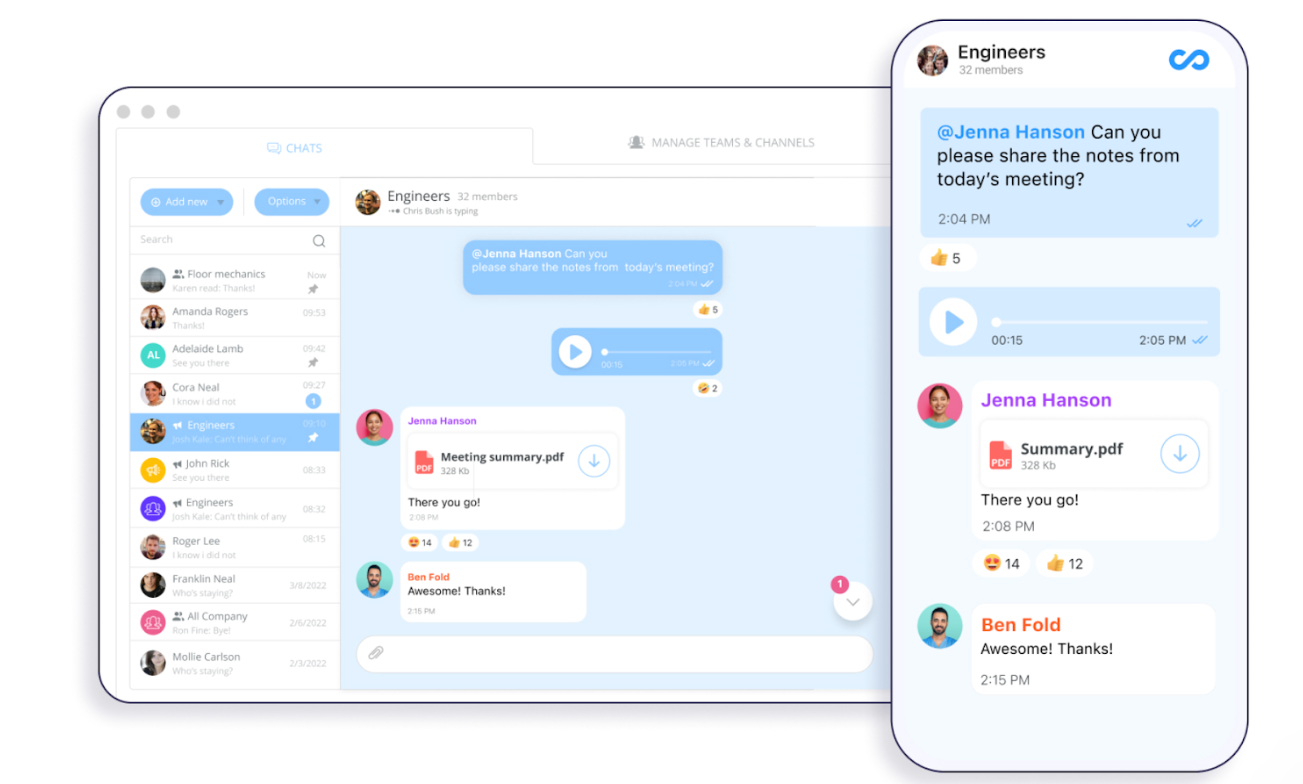
Key Features
- Mobile communication: chat, announcements
- Task management, checklists, forms, and surveys
- Schedules, time tracking, shift management
- File sharing and document workflows, push notifications
- Training modules, compliance, and internal policy delivery
Best for
- Teams that need mobile access to communication, tasks, and workflows
- Agencies with distributed staff who need scheduling and communication in one app
- Organizations that want to reduce the number of team communication apps remote workers use and optimize their workflows
11. Slack
You probably know Slack. It is a popular team communication platform that offers channels, threads, messaging, voice & video calls, and integrations. Its AI capabilities help summarize threads, pull meeting notes, and create meeting recaps. The app also integrates with tools such as Dropbox, Jira, Asana, and Zapier, making it a central hub for team collaboration.
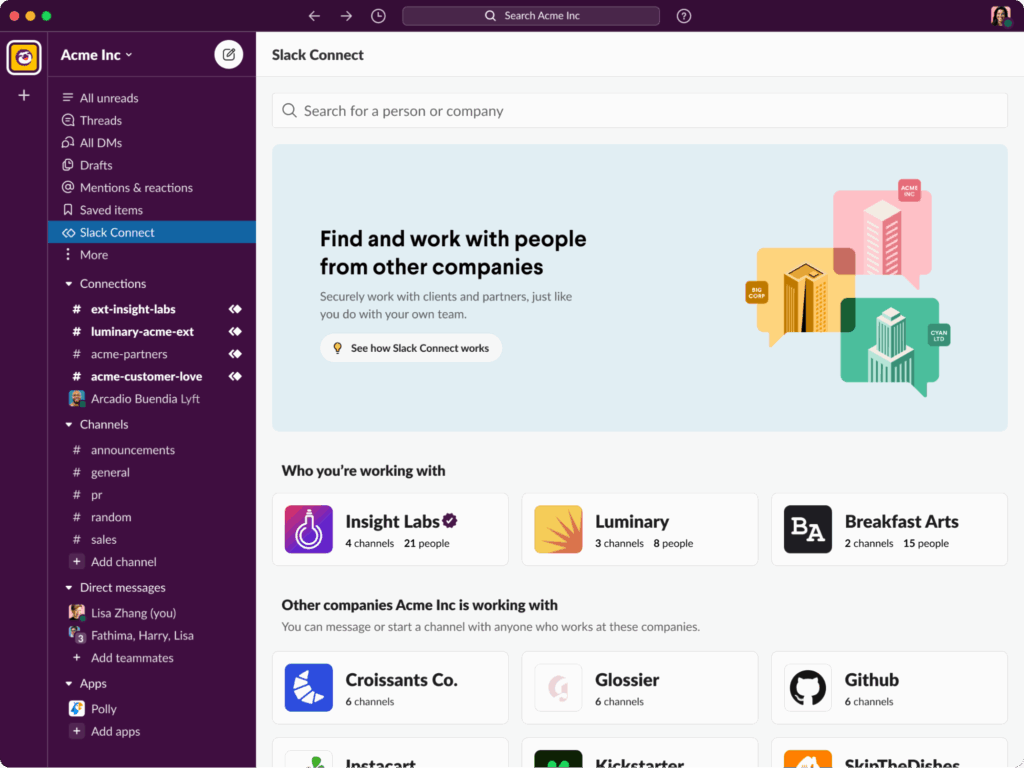
Key Features
- Channels, threads, direct messages
- Huddles and screen sharing
- AI thread summaries, recaps, translation, workflow builder
- Enterprise search across messages, files, and integrations
Best for
- Agency teams that need a flexible communication hub
- Cross-functional teams, such as product, marketing, or support, that need shared context
How to Choose the Right Tool For Your Agency
Now that you have a list of trustworthy team communication tools, the main question arises: What are the steps to choose the best software for your business? What should you consider before committing?
I have created a brief checklist with key steps and requirements for apps, so you know where to start.
1. Map Existing Communication Workflows
The first step is to document how your team collaborates. Identify where information gets lost. Is it client feedback loops, creative reviews, or internal approvals? The best team communication apps address pain points, but first, you need to define your problems. You can monitor a project from start to finish for a week and track communication flow to detect duplicate updates, missed messages, or extra tools.
2. Prioritize Rich Integration Options
The next step is to check the tools that professionals use most and ensure the new addition integrates with existing systems. Solid integration can save hours of manual updates and keep communication tied to work.
Example: Connect Sembly to your project management app or CRM, so meeting summaries with clients automatically populate corresponding fields. This way, professionals do not have to dedicate time to transferring information from one app to another.
3. Support Real-Time and Async Collaboration
More than 90% of knowledge workers agree that clear communication with their colleagues improves their work (Grammarly). This brings us to the third step. You need to ensure that the app enables chat, voice notes, and shared workspaces for asynchronous collaboration. Consider team communication apps that offer message summaries or AI recaps to help employees keep async updates concise and avoid losing context.
4. Check Scalability and Permissions
The next step is to check whether the app offers role-based access, guest accounts, and multi-workspace setups that support both internal and external collaboration. You can use separate channels for each client project, and centralize agency-wide announcements to maintain structure.
Tip: Map out what visibility your interns, freelancers, and clients should have. Check whether your platform supports these permission levels.
5. Evaluate Security and Compliance
Last but not least, confirm the platform offers end-to-end encryption, GDPR or SOC-2 compliance, and detailed admin controls. For agencies working with enterprise clients, security is mandatory as customer trust is at stake.
Tip: If your agency handles international clients, confirm that the platform hosts data in compliant regions (EU, US).
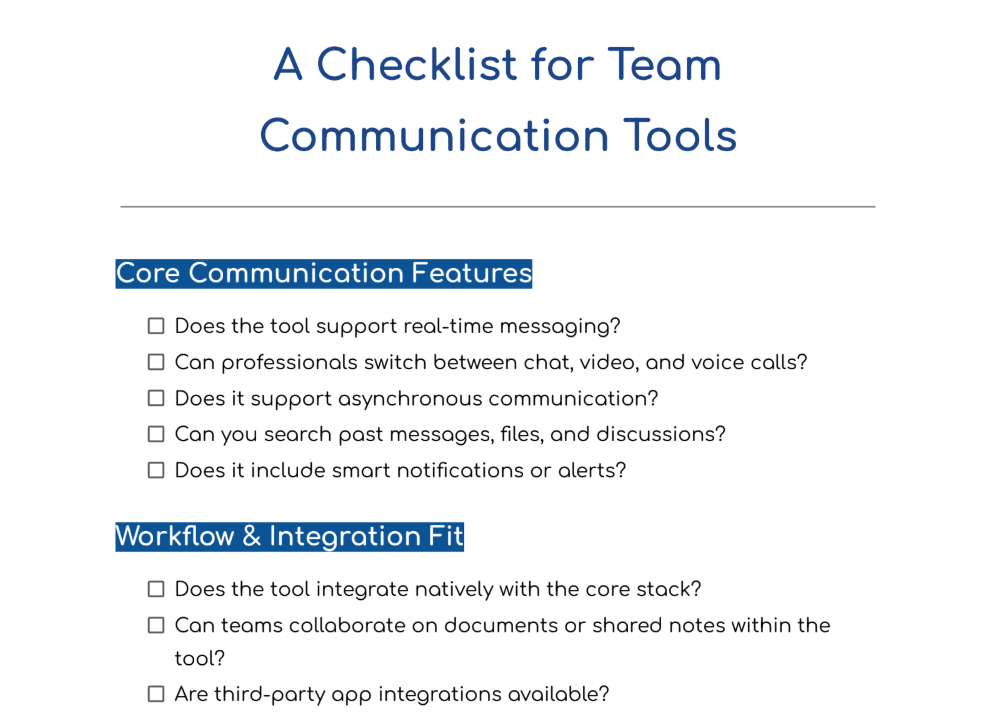
A Checklist for Choosing Communication Apps
For your convenience, there is a brief checklist that is structured into sections with yes/no questions. It will help your agency professionals evaluate potential team communication tools.
How to Successfully Introduce a New Communication Tool in Your Agency
Once you are done with the criteria for team communication software, you can outline an implementation plan. One of the most common mistakes is starting a trial without clearly introducing the tool. As a result, the testing period is often over before professionals can explore the key features and see the full potential.
Here is a brief plan you can use as a foundation for introducing a new solution:
- Identify employees to test team communication apps: Choose 2-3 professionals to test, document, and provide feedback for the new platform.
- Start implementation step-by-step: Roll out the app for specific use cases, such as client reporting or campaign planning, before expanding organization-wide.
- Communicate the reasons: Show how the tool addresses specific pain points: fewer lost updates, faster client follow-ups
- Integrate before training: Connect the platform with CRM, task tools, and shared drives to see immediate relevance.
- Gather detailed feedback: During the testing period, collect structured feedback and consider it for testing other candidates. For example, what works well and what distracts employees from working effectively.
The idea is to show your team the value the app brings to the table. Make it clear how it solves a daily problem, since when the value is specific, implementation happens naturally.
Wrapping Up
When the agency has the right team communication tools, collaboration becomes effortless. Designers stop chasing updates, client managers navigate through conversations, and marketers know exactly what’s happening with their campaigns. The key to choosing the right app is to consider existing workflows, create a list of apps you need to integrate with, check collaboration options, and compliance certifications.
I hope this article has introduced you to some of the effective communication apps for business, and the next tool you choose can improve your results. Good luck!
FAQ
Can AI improve team communication?
Yes. AI can help agency teams reduce noise, extract key information from calls, as well as collaborate and align. AI team communication tools such as Sembly can record and transcribe meetings, extract action items, and generate summaries across multiple calls.
You can use AI recaps for async standups, client updates, and cross-functional briefings.
What are the best communication tools for agency teams?
Here are 10 team communication tools worth considering, each designed for specific agency needs:
- Sembly: Best for automating meeting documentation, creating summaries & notes, and extracting AI insights & tasks from calls
- Slack: Best for real-time messaging, integrations, and cross-functional communications
- Connecteam: Best for mobile-first teams, task workflows, and frontline operation teams
- Workvivo: Best for internal communications, employee engagement, and company updates
- Staffbase: Best for structured internal campaigns and multi-location teams
- Flock: Best for combining messaging with built-in productivity features
- Spike: Best for chat-style email, shared notes, and unified communication
- Blink: Best for hybrid teams that need mobile communication
- Zulip: Best for async chat with structured threading
- Axero: Best for intranet-style communication and content hubs
- Microsoft Teams: Best for agencies that actively use Microsoft 365 tools and want a communication tool that seamlessly integrates into their workflows
What is the difference between team communication tools and collaboration tools?
Team communication apps focus on how teams talk, including messaging, calls, updates, and company announcements. Collaboration tools focus on what teams create together. For example, tasks, documents, planning, and feedback.
Are asynchronous communication tools effective for agencies?
Yes, especially when it comes to globally distributed employees. Async team communication tools help people to share information and respond when they are available, without interrupting focused work.
You can use async updates for standups, briefs, approvals, and status reports.
What are the key features of good communication tools?
Here are 6 key features to look for in great team communication tools:
- Real-time and async support
- Searchable history across messages, files, tasks
- Role-based permissions for client and team access
- Integrations with key project management, documentation, collaboration tools, and CRMs
- AI features
- Security & compliance
- Multi-meeting chats
- AI Insights
- AI Artifacts
